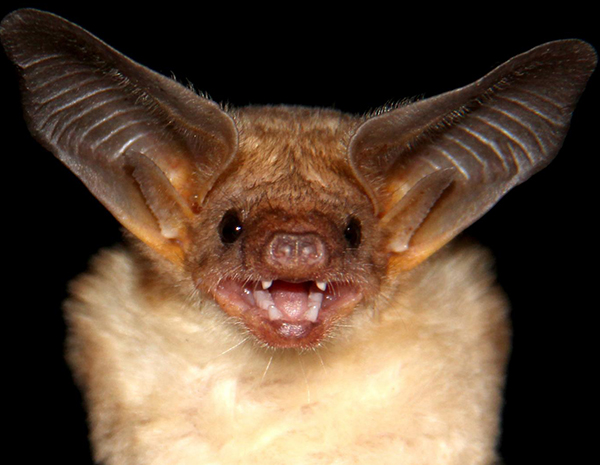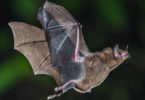Bats in the Attic
This is an educational guide to assist you if you have a bat problem in your home or building and want to get rid of bats in the attic. It is written by a professional bat removal expert who has performed over 500 bat removal jobs, in every type of building, with a 100% success rate, and without ever killing a bat.
First off, I have to say that if you know what you are doing, you can solve your bat problem permanently. But it is not an easy task, especially if you are not experienced. I trained with an expert for two years, got my Bat Conservation International certification, and even then I required many jobs on my own before I truly got good at bat removal from attics and buildings.
Second, I want to make it clear that the and only legal, the only humane, and by far the most effective, way to remove bats from an attic is with a live exclusion. None of the bats are killed in the process.
Above are some photos I’ve taken at various bat jobs. On the left, you can see a group of bats swirling inside a house. In the middle, is a huge swarm of bats, over 1000, entering and exiting a hotel 8 stories up. On the right is a photo inside an attic with a large bat infestation.
Inspection: You have to find out how the bats are getting in and out of the building, where they are living, what species they are, and what damage they have caused. They fly out at dusk, and fly back at dawn. Not all at once, and they make several trips in and out per night. They usually roost in tight, hot areas in the structure. This means that they often roost in attics. However, they are not out in the open. They usually crawl down walls and wedge into gaps behind wood beams, fascia boards, etc. They can leave millions of droppings (guano) all over your attic. The exact species of bat is very important in performing the exclusion properly, because of different sizes, behaviors, and most of all birthing seasons.

Bats in the roof
Control
Many bats are endangered or threatened, so both UK and European legislation gives them very full protection. It is illegal to intentionally kill, injure or take any bat or to recklessly damage, destroy or block up their roosts or disturb them. Because bats tend to return to the same roosts each year, these sites are protected whether the bats are present or not. Therefore the council is unable to offer any pest control services for bats.
Bats in roofs
The 16 species of British bats are all small harmless mammals which feed only on insects. During the day, bats use a variety of places, including house roofs, for roosting and they form colonies at some times of the year. Bats do not damage property and there is no known health risk associated with them
In dwelling-houses that are used by bats, the legislation allows building maintenance or remedial operations to be carried out. However, Natural England must have been notified in advance and allowed time to advise on whether the operation should be carried out and, if so, the method and timing of the work
Where structural, demolition or conversion work is proposed to buildings that are not dwellings (e.g. churches and barns) it is necessary to consult the Department for Environment Food and Rural Affairs (DEFRA) about licensing implications before any work can proceed.
This explanation should be regarded only as a guide to the law, and the Wildlife and Countryside Act 1981 (as amended) or the Conservation (Natural Habitats etc.) Regulations 1994 should be consulted if in doubt. Many species of bat are dependent on buildings for roosting, though they may not be present throughout the year

How to Get a Bat Out of Your House
So you have a bat in your belfry, huh? Wanting to get rid of it is understandable. Sure, there are benefits to having bats around; they eat pesky mosquitoes, moths and beetles, for example. But their droppings can make quite a mess, and if they get into your living space, you run the risk of someone being bitten.
Most of the time, bats end up in your home accidentally. They may chase an insect through an open window, or they may get confused while finding their way in the dark. If one is resting on the outside of your house and gets startled, it may dart in through an opening
Encouraging an exit
Never try to catch a flying bat, says the Bat Conservation Trust. Doing so could injure the bat, or it could bite you in self-defense. Instead, encourage the bat to leave on its own or wait until it lands to catch it.
To help the bat find its way out, first remove all pets and children from the room, then close all doors to the room, open the windows as wide as possible and dim the lights. Turn off any outside lights near the exits. Then quietly wait for it to show itself out.
To make sure it has flown out, check high spaces, such as in curtain folds or behind wall decorations, the Bat Conservation Trust advises. But also check low spaces, because if the bat is injured, it may have flown down to hide.
How To Get Bats Out of Your Attic
Bats are removed from the attic with a live exclusion. This is the best way. It is the most effective, and the only legal way, as well. A live exclusion means that you install a one-way door or one-way netting devices which allow the bats to exit the building freely, as they do each night, but then not get back inside. It’s a simple concept, but it’s difficult to execute effectively
Bat removal can be a complex task, because the bats can enter a building through very small cracks – as small as 1/4″ – it’s amazing! They almost seem to disappear into nothing! The holes and gaps that bats use are usually located high on a building, at roof lines, and can be tricky to access. A bat removal job requires utmost attention to detail
It also requires adherence to state laws protecting bats. For example, never perform a bat exclusion during the summer, because of the flightless baby bat pups in the attic! I myself trained in bat removal for two years, and still needed a fair amount of practice to perform bat removal correctly. Our network of wildlife removal professionals on this site are excellent in bat control
Information About Bats in the Attic
Are there baby bats? Yes, that’s the reason bats enter the attic. These bats can live in very large groups, called maternity colonies. The bats in your attic are all females. They give birth to one pup each, usually in the month of May, but it can vary depending on species or local climate. The pups in the attic are flightless during the summer months, while the females nurse them. This is called the maternity season, and you absolutely cannot perform a bat exclusion during this time, because you will trap the young baby bats inside! It’s illegal, and a terrible event, because the baby bats start to crawl around and they often get inside the house, or they starve and die and rot and cause a bit odor problem.
What species of bats are in my attic? The United States is home to three common species of colonizing bats: The Little Brown Bat, the Big Brown Bat, and the Mexican Free-Tail Bat. There are some other colonizing species of bats that choose to roost in attics, but those are the major three. You can identify them by entering the attic and spotting them, although to be honest, this can be very hard – they don’t just hang from the ceiling or raftors. They clump up in tight packs under gaps, behind beams, down walls, and areas like that. Hundreds of bats can cram into very tight quarters. You can also identify them by observing them fly out. If you live in the south, it’s more likely to be Freetail bats, and in the north, the big brown or the little brown, which you can identify by size and size of droppings. It’s important to know the species, so you can tell the bat birthing season.
Rid Your Attic of Bats
So, have you just bought a new house in the countryside? Maybe it is not new; actually, let’s face it, if those walls could talk… Still, that is part of its charm! In the end, what is better than a lovely rustic place of your own away from traffic jams, pollution and noisy cars? Yes, you finally have that place to get away from it all! Whether it is for a few weekends every month, or to send your children away from the pollution, stress and, let’s be honest, even the dangers of city life during the summer months, you now have a place you can call your home to go to… Set in the best surroundings you could possibly find, maybe surrounded by wild fields and forests, rivers and mountains, that lovely place of yours has been empty for some time, but that is the place your heart wants to call home… Perhaps you are even considering retiring to this beautiful spot in the country when you are older, or when you can afford it? Great
Maybe you have decided to live in the countryside, as some friends of mine have done, to grow up your children? You have left the city and, having found that beautiful cottage, farm, or old house, you have invested all your savings and are ready to make the big step and move in? Let me tell you that I am really happy for your choice; I understand it and support it wholeheartedly.
So you are looking forward to a bucolic life surrounded by green trees, wild prairies, birds and butterflies? Many days of joy will be coming to you in the year to come… However as you actually move in, or start inhabiting the place, you notice something you had not spotted at all when you first visited the place during the day… Yes, because when you spend your first night in your new home, your attention is caught by some unusual movements and sounds above your head. “Well, I don’t mind,” you think at first, “there must be some birds on the roof; they will soon go…” But days go by and the little sounds (not chirps, you realise) continue, so does the nigh time activity… So, you decide to take the ladder and have a look at who dwells in your attic.
Bats are not usually aggressive to humans (with some exceptions, like Vampire Bats, who live in South and Central America, who have been known to attack people even if very rarely). So, forgetting horror movies like Dracula and the like, you will not likely be under direct attack by these little nocturnal animals.
However, some bats carry viruses and bacteria that can be dangerous to us. The risk of infection is actually quite low, but if you handle them, it rises significantly. That is why only trained and vaccinated people should catch bats